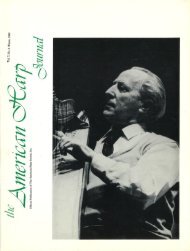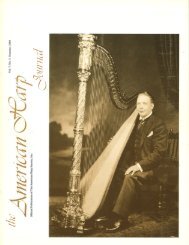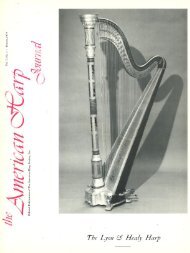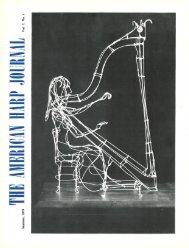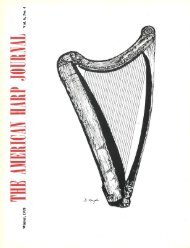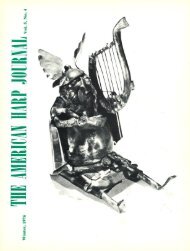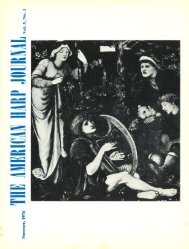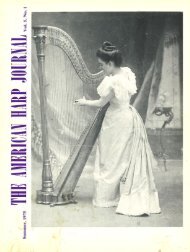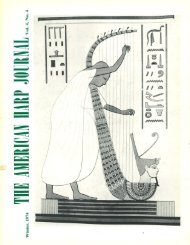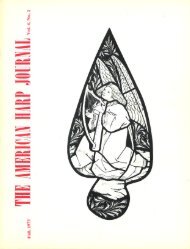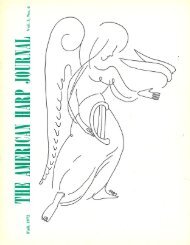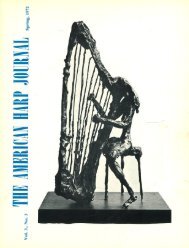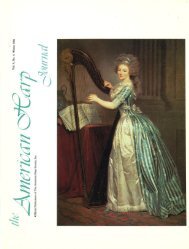You also want an ePaper? Increase the reach of your titles
YUMPU automatically turns print PDFs into web optimized ePapers that Google loves.
after an audition in Vienna, Haydn proposed that he<br />
become harpist in the chapel of Prince Esterhazy.<br />
Returning to Paris in 1777, Krumpholtz soon became<br />
the teacher of people in polite society and (as we have<br />
seen) made his debut at the Concert Spirituel on Christmas<br />
Day 1778.<br />
Krumpholtz married the sister of a lute maker of<br />
Metz, Marguerite Gilbert, who soon left him a widower<br />
with two children. Bad luck would have it that he should<br />
be attracted to one of his pupils, twenty years his junior,<br />
the pretty Anne Steckler, daughter of another lute<br />
maker of Metz, Christian Steckler. The new Mme.<br />
Krumpholtz, who had, in addition to her beauty, a remarkable<br />
talent for the harp, was the darling of the<br />
musical world for a dozen years ... So much so that in<br />
1 790 she ran away to London with a mysterious seducer,<br />
who, if one is to believe George Cucuel, could well<br />
have been the son of Fran9ois-J oseph Gossec.<br />
Poor Krumpholtz, devoured by jealousy, could not<br />
endure the flight of his wife, and threw himself into the<br />
Seine near the Pont-Neuf, February 5th, 1790.<br />
To the numerous acknowledgments that harpists owe<br />
to Jean-Baptiste Krumpholtz, let us add that it was he<br />
who had the idea of asking Sebastion Erard to interest<br />
himself in the mechanism of the harp. We know what<br />
came of that: Erard transformed the then imperfect<br />
structure of the instrument, and invented the double<br />
action which is still in use today, and which makes possible<br />
twenty-seven complete diatonic scales, whereas<br />
the old system had only thirteen.<br />
The new harp came out of Erard's workshop in 1811:<br />
Krumpholtz was not there to profit by an invention of<br />
which he had been the inspiration.<br />
From this high point we must descend to speak of<br />
Jean-Baptiste Cardon. It would be regrettable however<br />
to forget him. Son of a violinist in the royal chapel of<br />
Versailles, he was born at Rethel in 1760, and was, after<br />
I 780, teacher of harp to the Countesse d' Artois. The<br />
Revolution forced him (and many other musicians)<br />
to flee from France, but at a time when most harpists<br />
turned to England, Cardon chose Russia, where we<br />
find him after I 790, concert master at the court of<br />
Catherine II.<br />
He was a member of a small instrumental group consisting<br />
of clarinetist Joseph Beer, violinist Ferdinand<br />
Dietz, violincellist Alessandro Delfino, and pianist<br />
Ernest Vandjoura. This ensemble performed regularly<br />
in the apartments of the Empress.<br />
Although on the demand of Catherine he had signed<br />
a manifesto condemning the French Revolution, Cardon's<br />
contract was not renewed in I 793. Several years<br />
later he returned to France where he remained until<br />
1802. For reasons unknown he departed again for<br />
Russia, where he died in I 803.<br />
Jean-Baptiste Cardon has often been confused with<br />
one of his three brothers: Louis-Stanislas, a talented<br />
violinist. A modern edition of a sonata by Cardon maintains<br />
this error, disseminated by Fetis. Published after<br />
I 780, the work of J. B. Cardon (with some rare exceptions)<br />
consists of sonatas for harp and violin. These so-<br />
SPRING/<strong>1974</strong><br />
natas contribute nothing new to the technique of the<br />
harp, but they are the product of a virtuoso who knew<br />
his instrument very thoroughly. The most interesting<br />
collections of sonatas are unquestionably the following:<br />
I) 4 Sonatas for Harp with Accompaniment of<br />
Violin (Op. VII), Dedicated to Her Majesty<br />
Queen Marie-Antoinette.<br />
2) 3 Sonatas for Harp with Accompaniment of<br />
Violin (Op. IX), Dedicated to Her Majesty the<br />
Empress of all the Russias.<br />
3) 3 Sonatas for Harp with Accompaniment of<br />
Violin (Op. XI), Dedicated to Her Serene Highness<br />
Mme. The Grand Duchess Helene Pawlowna.<br />
In I 784, Jean-Baptiste Cardon published an Art of<br />
Playing the Harp, Demonstrated by His Principles,<br />
which all his biographers have confused with a<br />
"method", and which is, in reality, a set of excellent<br />
exercises.<br />
A harpist-composer who has also left some works<br />
which are very interesting from both a musical and a<br />
technical point of view was Francesco Petrini.<br />
In spite of his Italian name, Petrini was of German<br />
origin. Born in Berlin in I 744, he belonged to a dynasty<br />
of harpists: his father was harpist in the chapel of Frederick<br />
the Great, his sister Therese (born in Berlin in<br />
I 736) was, in I 754, harpist of the Margrave Charles in<br />
Berlin; his brother Henri was also a harpist who lived<br />
in Par'is in the shadow of Francesco.<br />
At the beginning of his career, in I 765, he had been<br />
attached to the chapel of the Duke of Mecklenbourg<br />
Schwerin. In 1769 Petrini arrived in France, and as was<br />
customary made his debut at the Concert Spirituel in<br />
1770.<br />
The first compositions of Petrini are in no way remarkable.<br />
The first sonatas, published in I 769, 6 Sonatas<br />
for the Harp with Violin ad lib., Dedicated to His<br />
Serene Highness Monsignor le Prince Louis de Rohan,<br />
Op. I, are awkwardly scored.<br />
The Six Divertimentifor Harp Solo, Accompanied by<br />
Flute and Bass (Op. IV) published in I 772, and the<br />
Duo for 2 Harps, Dedicated to Mlle. de Guines (Op.<br />
VII-1773) are better, but make no contribution to technical<br />
advancement. One must wait for 1786 and the<br />
First Concerto for Harp with Accompaniment of 2<br />
Violins, Viola, Bass, 2 Oboes, 2 Horns (Op. XXV) to<br />
have from Petrini a work which can rival the compositions<br />
of Krumpholtz and Hochbriicker. This concerto<br />
was performed Sept. I, 1786 at the Concert Spirituel by<br />
Mlle. Descarsins. But it is above all the 4th Concerto<br />
in B Flat Major, Op. XXIX which merits our sustained<br />
interest. It appears that after long hesitation Petrini<br />
set himself to write a work genuinely conceived for the<br />
harp, and in this he succeeded fully.<br />
This concerto consists of two movements. The first,<br />
allegro moderato, contains great arpeggios of four<br />
octaves, in triplet eighth-notes which produce an extraordinary<br />
effect on the harp, and light glissandi of an<br />
octave, an effect which was then a novelty. But above<br />
all, this movement contains a rather long cadenza<br />
written by Petrini which reveals the harp as the roman-<br />
17




